How to make your own Sourdough Starter, using simple ingredients with no special equipment, in just six days, that can be used in our sourdough bread. Video.
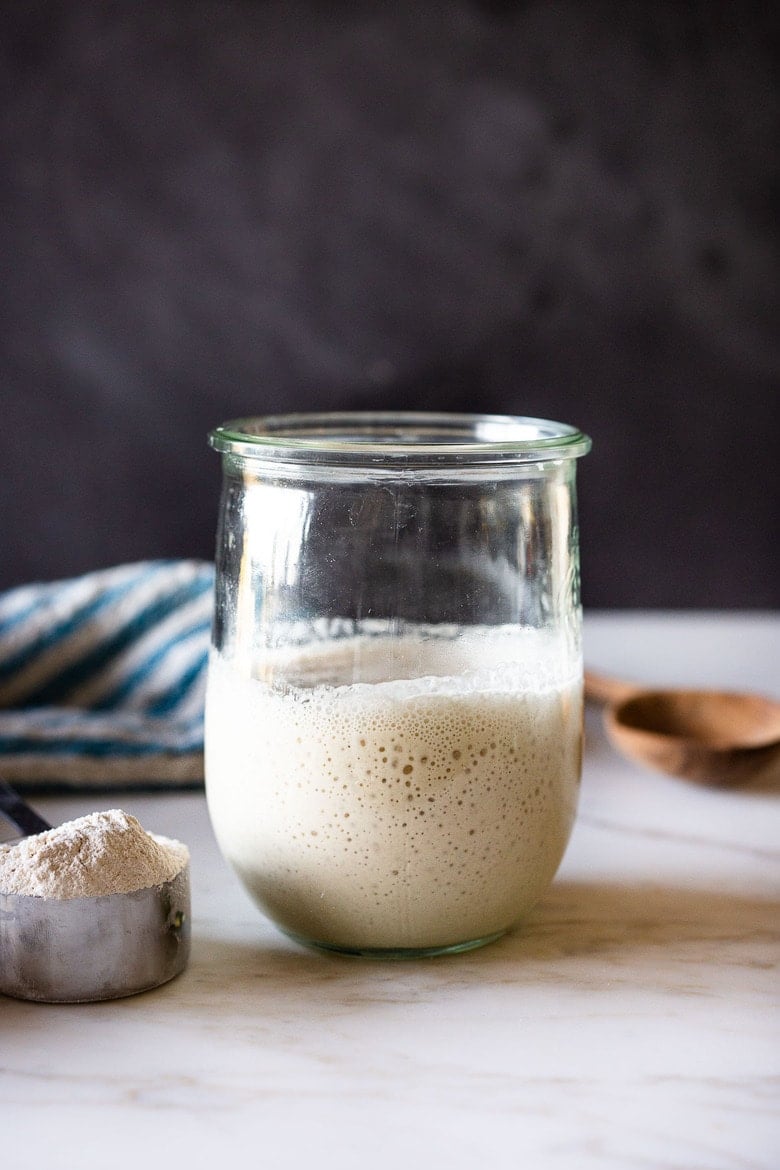
When you understand one thing through and through, you understand everything.~ Shunryu Suzuki
With over 500 five-star reviews and hundreds of success stories, my chef’s perfected sourdough starter guide has everything you need to make your own homemade starter. In just six days, you’ll be baking the most beautiful sourdough loaves!
But first, What is a starter?
Sourdough starter is a “wild yeast” made from flour, water, and the natural wild yeast in the air. With a little care and patience, it ferments, and when strong and active, just a little bit of starter replaces commercial yeast and makes your bread rise, while transforming the gluten in the bread into something more easily digestible. Store-bought yeast is not needed!
How to Make Sourdough Starter | 20-Min Video
***Don’t see the video? Allow 15-20 seconds to load it right here!*** (Still don’t see it? Check that your ad blocker is turned off; use Chrome for the best experience.)
Fast forward to Specific Day by video time (using scroll bar underneath video)
- Day 1 Morning: :23
- Day 2 Morning: 4:10
- Day 3 Morning: 7:00
- Day 3 Evening: 9:12
- Day 4 Morning: 11:50
- Day 4 Evening: 13:37
- Day 5 Morning: 14:45
- Day 6 Evening: 16:50
- Day 6 Morning: 18:12
- Day 6 Evening: 20:10
Sourdough Starter Recipe Ingredients
- Jar – A wide-mouth quart jar or a Weck’s 1-liter tulip jar.
- Flour – 5 lb bag of organic bread flour (plus 1 cup organic whole grain flour )
- Water – filtered water, tap water, or mineral water (specifically, San Pellegrino, for the correct mineral ratio). Distilled water does not have enough minerals.
- Scale – using a kitchen scale is optional but handy.
- Thermometer – Knowing the temp of the starter using a thermometer is optional but handy!
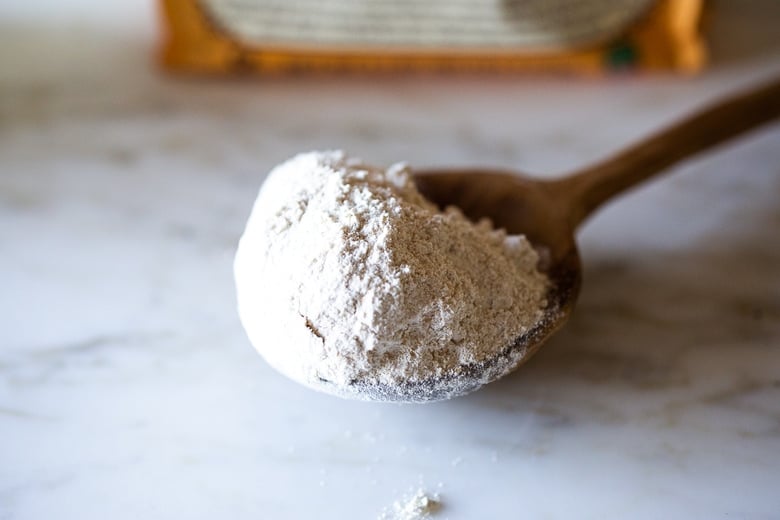
Understanding starter
- Think of sourdough starter as yeast. Only in this case, instead of buying a packet of yeast from the store, you are making your own living “wild yeast” by fermenting flour and water. Once it’s bubbly and happy, it is very much ike a very low-maintenance pet.
- You must feed it (stir in a mixture of flour and water) once a week to keep it active and strong. You know it’s happy when it bubbles. 😉 And YES, you can even name it.
- Some people believe that bread made with sourdough starter is actually better for you than bread made with yeast. Here and Here are a few articles to get you started on your own research. While I’m not sure if this is scientifically proven, I do know that bread made with sourdough starter, tastes infinitely better, feels easier to digest, and has more complexity and better texture, than bread made with commercial yeast. So if you are a bread lover- this is absolutely the way to go, as far as the quality of your finished bread.
How to Make Sourdough Starter
*See the recipe card for detailed instructions.
This recipe for Sourdough Starter takes 6 days (or up to 12 days if it is very cold where you live). For a primer, watch the 20-minute Sourdough Video above!
Day 1: Staring in the morning or at night, using a wide-mouth quart jar, tulip jar, or Crock or Glass Measuring Cup , mix 1 cup whole grain flour (120 grams) with 1/2 cup filtered water (120 grams) using a fork (or chopstick) making sure you’ve incorporated all the dry flour.
Place the lid lightly on top (using the Weck jar lid is really handy here) or a wet towel to keep moisture in, or plastic wrap- and let sit at room temperature (70-ish degrees) on the kitchen counter for 24-48 hours. If you are unsure how warm it is, use a kitchen thermometer and check it a few hours later. See notes for TEMPERATURE.
TIP #1: For your first measurement, weigh the flour using a kitchen scale so you can get an idea of how the mixture should feel. Do not weigh the measuring cup! It should be like a thick paste, like peanut butter. If you need to add a little more water to incorporate the flour, that is OK too!
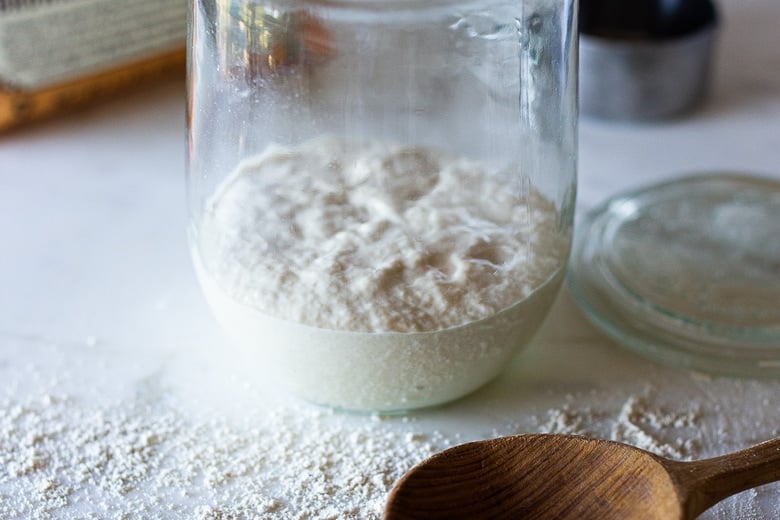
Day 2: After the first 24 hours, there may or may not be a bit of bubbling. Let the mixture rest until you see activity (bubbles or rising) sometimes this takes 36 hours or even 48 hours if very cold. When you see active bubbling, discard all but 1/2 cup of the starter (4 ounces).
To the remaining ½ cup of starter, stir in 1/2 cup water (120 grams), and mix well with a fork. Add 1 cup of organic bread flour (120 grams)spooned and leveled. Stir until combined. Again, it should feel like a thick paste. If overly dry, feel free to add a bit more water. Cover again and allow the mixture to sit at room temperature for another 24 hours.
Day 3: After 24 hours, hopefully, you will see some bubbling or rising and if not, let it go a bit longer until you see activity. Be patient.
Depending on how warm your house is and how active your starter, you may need to begin feeding more often or move to two feedings a day, in the morning and at night. If it is cold, one feeding a day may be enough.
TIP #2: Only feed the starter after it has peaked or looks hungry. See the “3 Signs of Hunger” below. Feeding it when it is “not hungry” will basically dilute all the growing yeast and make it lethargic. Better to underfeed than overfeed.
The 3 Signs of hunger
The photo below was taken after the starter was fed, and after it peaked (reached its highest), and now is sliding down. It is now “hungry” again. See the downward slide marks on the jar? Pay attention – your starter is telling you it is hungry.
- Look for “slide marks” (be sure to use a clean jar so you can see these clearly).
- Liquid at the top of the starter.
- Thin and runny. The starter is liquidy enough to pour out of the jar (when at room temp).

This might be 12 hours, it might be 14, it might be 18, or 24, depending on the temp in your house. In very warm climates, it may only be 6-8 hours. In winter, this may take 36 hours. It is better to underfeed rather than overfeed here.
For each feeding, discard all but 1/2 cup of the starter (keeping roughly ½-cup of starter in the jar). Add 1/2 cup water and 1 cup Bread Flour (spooned and leveled). Mix well, cover, and let this rest at room temperature for 12-24 hours or until the starter looks “hungry” again before repeating.
Day 4: Feed 1-2 times, discarding all but 1/2 cup of starter each time. Feed 1 cup bread flour, 1/2 cup water.
TIP #3: It is typical on day 4 for the starter to slow down and stall a bit. This is OK. Just keep going, be patient and look for the hunger signs, and only feed when clearly hungry. Hopefully, you’ll begin to see some rising and falling. It’s helpful to put the starter in a clean jar each day and mark the beginning level (with a sharpie, string or rubber band) so you can easily see this.
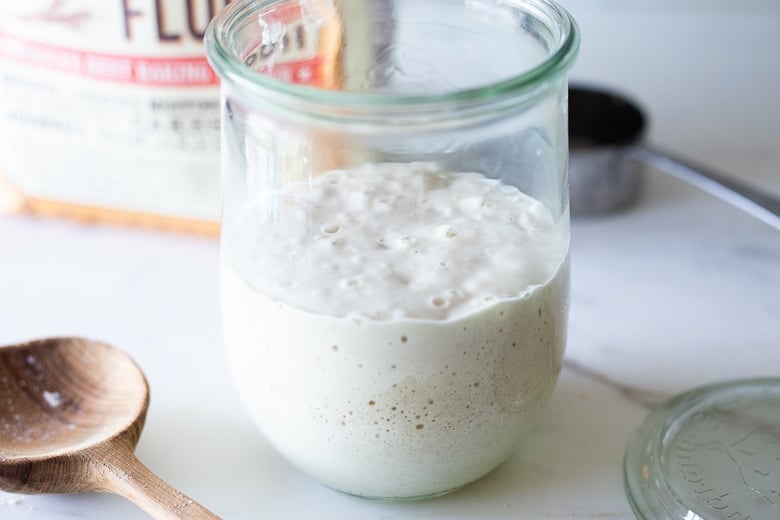
Above, you’ll see it peaking, and below, you’ll see it deflating and getting “hungry.” There may not be too much difference in the beginning, so look closely.
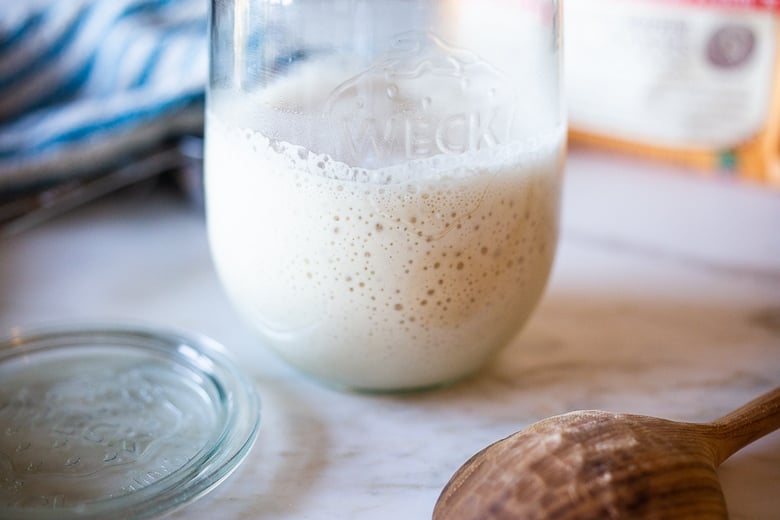
Understand that your starter has a schedule of its own; it is a living thing, so watch it and pay attention.
If your starter is not rising and falling, look at its consistency. As it metabolizes the flour and gets hungry, it will get runny and liquidy, like to the point where you can pour it right out of the jar. If it is still thick like paste, it’s not done metabolizing (eating)the flour.
Day 5: Feed again, 1-2 times, discarding all but a 1/2 cup the starter each time. Adding 1 cup bread flour and 1/2 cup lukewarm water. The starter should look visibly active, bubbling, rising, hopefully, close to doubling in size.
Repeat day 5 until the starter is rising and falling predictably and is close to doubling in size within 6-8 hours.
TIP #4: If your starter is not rising but there is evidence of hunger (liquidy or liquid at the top) try 3 things: substitute 1/4 cup whole grain flour (add to ¾ cup white bread flour) on your next feeding. Try using mineral water like San Pellegrino instead of water. Stir the starter a few times after feeding to allow more wild yeast from the kithcen to get inside.
DAY 6 Morning: Baking day! Give it one last feeding in the morning: this time discard all but a 1/3 cup. (The reason we are changing this to 1/3 cup is to feed it a little bit more.) Add 1 cup flour (120 grams) and 1/2 cup water, stir, and place it in a clean jar so you can see the action clearly. You can use a sharpie or place a rubber band around the jar to mark the beginning level. The starter should hopefully double in volume within 6-8 hours of feeding.
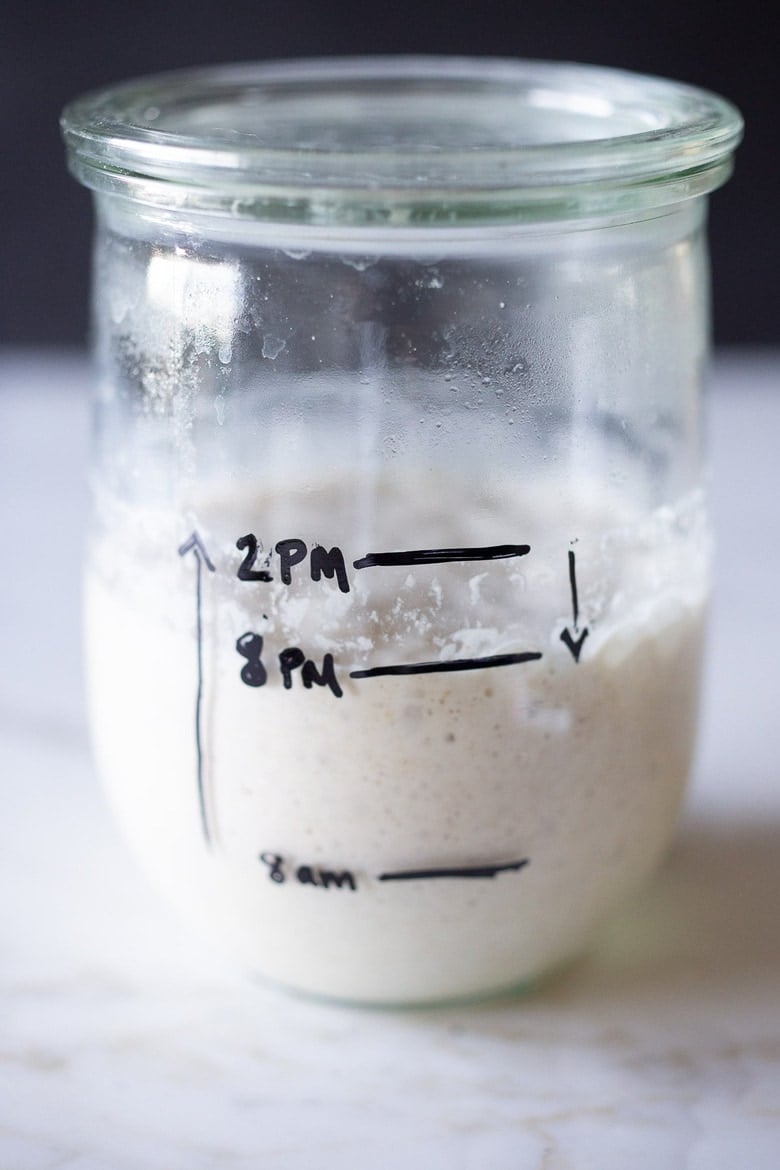
In the photo above, on the 6th day, the starter was fed at 8 am, it peaked around 2 pm, then it started deflating, and by 8 pm, it was “hungry” again. See those downward “slide” marks on the jar?
DO THE FLOAT TEST: When the starter is at its peak, or just after, place a teaspoon of starter (just from the top, don’t stir it down) in a glass full of water; it should hopefully float. If it floats, success!!! Congrats. You can now make our sourdough bread…tonight!
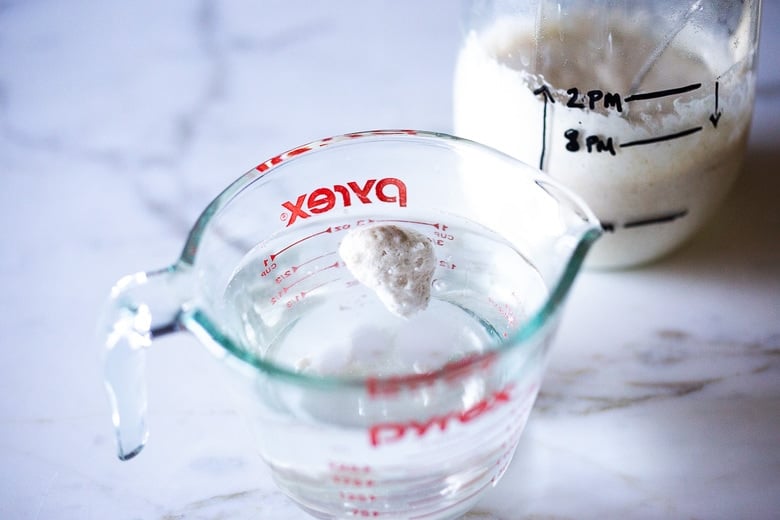
TIP #5: When baking bread always use hungry starter that has already peaked!
STARTER DOES NOT FLOAT? If it doubles in size but does not float, you can still try baking a loaf if it doubles within 6-8 hours of feeding it.
At this point, if your starter does not double in size within 6-8 hours of feeding, don’t give up! Often, it just takes longer, especially during the winter months. Continue feeding one to two times a day until you see a consistent, predictable rise and fall.
Read the troubleshooting section. If you need to take a break, put it in the fridge and try it again up to a week later. Don’t toss it!
Day 6 Evening: Let’s Bake! Use 1/3 cup starter to make this sourdough bread recipe and place the remaining starter (or if not making bread, place all of it) in the refrigerator, and feed it at least once a week, reserving ½ cup starter, before feeding it the usual 1 cup bread flour, 1/2 cup water.
TROUBLESHOOTING Starter
- SMELL: Starter should smell sweet, tangy, earthy, like a wet horse – not “bad”. If it really smells foul or unpleasant, you may have used an unclean jar, unclean utensil, or somehow introduced other bad bacteria. I would start over.
- NO ACTION: On day 4-5 it is typically for it to slow down. If your starter is not rising at all but there is evidence of hunger (liquid at the top, or bubbles) try 3 things. First substitute 1/4 cup whole grain flour (add to ¾ cup white bread flour) on your next feeding. If no rise, then try using mineral water, specifically San Pellegrino instead of water. San Pelligrino specifically has the right mineral ratio, I have great luck with it. Others not so much! Also try stirring the starter a couple of hours after feeding, a couple of times throughout the day to allow wild yeast from the room to get in there. Lastly, you could try pineapple juice instead of water.
- FLOUR: Try to use fresh milled whole grain flour to start, then organic BREAD FLOUR. The more wild yeast in the flour, the better your starter will do- so smaller brands like Bob’s Red Mill seem to do better than bigger conventional brands that have been overly processed. It is totally OK to mix flours and to switch them up- this adds different kinds of wild yeast- a good thing!
- DO NOT overfeed. For example, maybe feeding 2 x day at 12-hour intervals is too often. You want to feed after the starter has peaked, then deflated (see photo above- you’ll see some slide marks on the jar) and this tells you that it is hungry. If you feed the starter before it has had a chance to metabolize (or eat) all the flour (before peaking) and then you discard part of it, and feed it again, you are actually diluting all that amazing bacteria, weakening your starter. So it’s all about watching your starter in your home. If you are not seeing rising and falling, but notice the starter just gets liquidy, this too is a sign of “hunger”. Or if it gets runny enough to pour out of the jar, another sign it is hungry. There are lots of variables here. Just be patient, pay attention and watch. This is a living thing- it doesn’t care about time schedules and recipes or what it “should” do. It will “eat” when it is “hungry” and sometimes it likes to eat slowly. 😉
- TIME: It may take longer than 6 days in colder environments. Use a kitchen thermometer and take its temp. Is it over 65F? Find a place where it can be warm. In the oven with the light on, or in an upper cupboard ( heat rises). Sometimes it takes 12-14 days! Be patient, keep going. If it is doing absolutely nothing, leave it out on the counter for 24-48 hours and see what happens. If you run out of flour or need a break, don’t just toss it, put it in the fridge and see if you can get it going a few days later.
- ACIDITY: If you still can’t get that starter going, some people recommend subbing pineapple juice for the water for one feeding- raising the acidity level. My good friend just tried this and it got hers going.
- LIQUID: If you see any liquid at the top of your starter, it means your starter is hungry. So, yes it’s still alive which is a good thing! You can stir the liquid in, or pour the liquid out, either way, but feed it. This is a sign that you may need to feed it more often.
- MOLD: if you see any discoloring or mold on the surface, starter was probably contaminated. If it is only on the surface, it is probably ok to save. Scrape it off, save 1/2 cup of the underneath starter, and keep going, using a clean jar. Feed, smell, use your best judgment.
- FLOAT TEST: Try testing when your starter is peaking. Take a spoonful from the top without stirring it down. If your starter is rising and falling consistently, but not passing the float test and it has been over 8-10 days- just try baking a loaf. People are having luck with good loaves without passing the float test. It may be the flour…
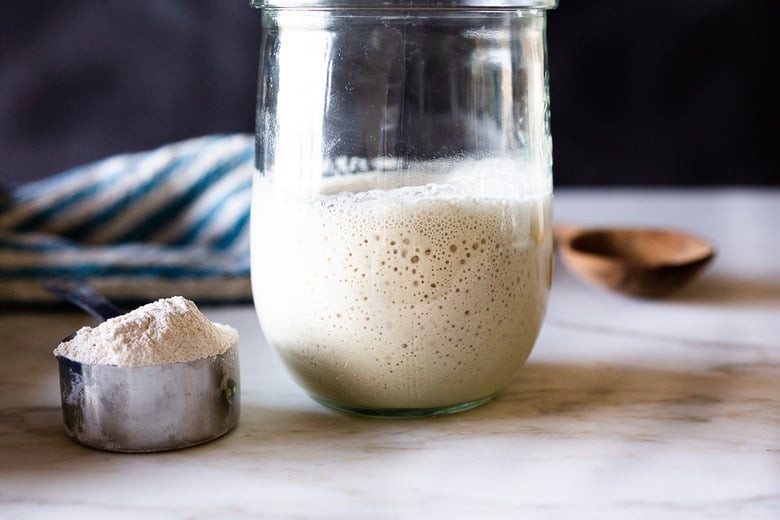
How to Maintain Your Starter
- REFRIGERATE & FEED AT LEAST ONCE A WEEK: Pick a scheduled day and try to stick with it, always reserving 1/2 cup and feeding it 1 cup flour and 1/2 cup water. Discard the remaining, give it away, or keep the discard in a separate container for sourdough pancakes, sourdough buns, banana bread, biscuits, etc. I usually don’t feed the discard unless I give it away.
- If you forget to feed it one week, it is most likely OK; feed it 1-2 times a day for 1-3 days in a row to revive it (keeping it out on the counter) until bubbly and active and doubles within 6 hours. I’ve left my starter for a month on vacation (in the fridge) without feeding and simply revived it by feeding it 3 days in a row, 1-2 x day. It’s surprisingly hard to kill. You can also freeze it for more extended storage.
- This batch will allow you to bake 2 loaves of bread per week with enough left to feed for the next week. If you want to bake more often, you can keep it out and feed it 1-2 x daily. Or if baking every few days, you can pull it out of the fridge, feed it 10 hours before using, leaving it out, use what you need while it is peaking (or slightly after), then put it back in the fridge that evening. Do the same thing a few days later when ready to use again. So this would be feeding 2-3 times a week, best if baking 4-5 times a week.
The best time to use sourdough starter is just after it peaks or on its way down when you know it is hungry.
Sourdough Bread Starter FAQs
Yes. While you are building your starter, during the first week, it is the simplest, easiest, fastest, and most economical way to create a healthy starter. (Or save it separately -in the fridge- and use it in Pancakes, Waffles, Buns, or Biscuits. ) This is because you always have to feed it two times its volume in flour. For example-if you kept all the 1 1/2 cups of starter, you would have to feed it 3 cups of flour (instead of keeping just a 1/2 cup and only feeding it ONE cup). Discarding will shorten the fermentation process, require less flour in the long run, and create a stronger starter. Once your starter is “established” after the first week- then you can give it away to friends, use it in pizza dough, pancakes, etc) or give it to a friend.
How to use your Sourdough Starter
- See all our Sourdough Recipes!
- Sourdough Scones
- Sourdough Crackers
- Sourdough Biscuits
- Sourdough Buns
- Sourdough Tortillas!
- Vegan Banana Bread
- Overnight Sourdough Waffles
More from Feasting At Home
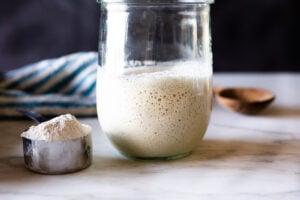
Simple Sourdough Starter
- Prep Time: 30
- Cook Time: 6 days
- Total Time: 144 hours 30 minutes
- Yield: 1 ½ cups
- Category: sourdough, fermented, cultured, bread, baking,
- Method: fermented
- Cuisine: bread
- Diet: Vegan
Description
How to make your own Sourdough Starter (see the step-by-step video in post) using simple ingredients with no special equipment, in 6 days, that can be used in sourdough bread. Sourdough Starter is a wild yeast, made from fermenting flour and water.
Ingredients
- 120 grams whole grain flour (whole wheat flour, rye flour, or freshly milled flour) 1 cup, fluffed, spooned and leveled
- Organic White Bread Flour (5-10 lb bag ) I like Shepherd’s Grain or Bob’s Red Mill.
- 120 grams Water per feeding (1/2 cup water)
Instructions
-
- Day 1: Starting in the morning or at night, using a wide-mouth quart jar or Crock or Glass Measuring Cup mix 1 cup whole grain flour (120 grams) with 1/2 cup (120 grams) filtered water using a fork making sure you’ve incorporated all the dry flour. For your first measuring – it is a good idea to weigh the flour, using a kitchen scale so you get an idea of how thick it should feel. It should be like a thick paste. Thick like peanut butter. If you need to add a little more water to incorporate the flour, that is OK, but be precise with the flour. Place the lid on top (using the Weck jar is really handy here) or a damp towel to keep moisture in, or plastic wrap- and let sit at room temperature (70-80 degrees) on the kitchen counter for 24-48 hours, or until you see some bubbling. If you are not sure how warm it is, use a kitchen thermometer and check it a few hours later. See notes for TEMPERATURE.
- Day 2: After the first 24 hours, you may or may not see a bit of bubbling. I prefer to let this rest until I see a tiny bit of activity (bubbles) and sometimes this takes 36 or up to 48 hours. So start “day 2”, when you see a little bit of bubbing. Discard all but 1/2 cup (136 grams) of the starter. (See notes for discard). Add to the remainder, 1 cup of white bread flour, (120 grams), spooned and leveled, and 1/2 cup filtered water (120 grams), mixing well with a fork. Place the lid on loosely again and allow the mixture to sit at room temperature (70-80F) for another 24 hours.
- Day 3: By the third day, you should definitely see some bubbling- and if not, let it go a bit longer. Depending on how warm your house is and how active your starter, you may need to begin feeding more often, or even move to two feedings a day roughly 12 hours apart, like in the morning and at night. In a nutshell, you want to feed the starter only after it has peaked (metabolized all the flour from the last feeding) and has started sinking down or gets liquidy- this is when it is hungry! This might be 12 hours, it might be 14, it might be 18, or 24, depending on the temp in your house. In very warm climates it may only be 8 hours. It is better to underfeed rather than overfeed here. For each feeding, like before, discard all but 1/2 cup of the STARTER (keeping roughly ½-cup of starter in the jar -4 ounces or 136 grams) Add 1 cup Bread Flour (spooned and leveled) and 1/2 cup water to the 1/2 cup starter and let this rest at room temperature for 12-24 hours or until the starter looks “hungry” again before repeating.
- Day 4: Feed 1-2 times, discarding all but 1/2 cup of starter EACH TIME. Feed 1 cup bread flour, 1/2 cup water. Look for the hunger signs. Hopefully, you’ll begin to see some rising and falling. It’s helpful to put the starter in a clean jar and mark the beginning level (with sharpie, string or rubber band) so you can easily see this. ***If for some reason your starter looks like it is still rising at the time of second feeding (at night) and there is no evidence it has fallen or no slide marks, it is still “eating” so skip this feeding and feed first thing in the morning. AGAIN, Feeding it when it is “not hungry” will basically dilute all the growing yeast and make it lethargic. Better to starve than overfeed.
- Day 5: Feed again, 1-2 times, roughly 12 hours apart, or when hungry, discarding all but a 1/2 cup the starter EACH TIME. 1 cup bread flour, 1/2 cup lukewarm water. The starter should look active, bubbling, rising, sliding down, hopefully, close to doubling in size. (If not, repeat this day until starter doubles in size within 8-12 hours of feeding- and read the troubleshooting section.)
- DAY 6: Give it one last feeding. Discard all but a 1/3 cup. Add 1 cup flour ( 120 grams) and 1/2 cup water, and place it in a clean jar so you can see the action clearly. You can use a sharpie or place a rubber band around the jar to mark the beginning level. The starter should hopefully double in volume within 6 hours of feeding. When it peaks, DO THE FLOAT TEST: To test the starter, place a teaspoon of starter (just from the top, while it is peaking, don’t stir it down) in a glass full of water, it should hopefully float. If it does, you can make sourdough bread. Tonight! Let the starter keep resting at room temperature or a few more hours allowing it to fully metabolize the flour, perhaps sinking a little before making your dough. You want to make dough with slightly hungry starter. Place the remaining starter in the fridge and feed it in a week. You’ll have enough stater to make one more sourdough loaf during the week, and still have enough to feed. If you want to wait to make bread until later in the week place starter in the fridge. Be sure to feed it in 7 days. Read maintenance section.
- At this point, if your starter does not double in size don’t give up! Often it just takes longer, sometimes up to two weeks, especially if it’s cold. Continue feeding one-two times a day (only when hungry) for a few more days, until you see a visible rise and fall. Read the troubleshooting section. If you need to take a break, just put it in the fridge and try it again up to a week later. Don’t toss it- if there are bubbles, it is still alive.
- This batch of starter will make two loaves of bread with enough left over to feed for the following week.
Notes
- TEMPERATURE: The colder your home, the longer it will take for the starter to grow and become active (bubbles). Find a warm spot (70-80 degrees) for the best results. On the stovetop, with the light turned on, or on top of the fridge. Or in the oven with the light on. On top of a heating pad (set to low) with a towel in between). You can still make the starter in a colder home, it will just take longer- even up to 2 weeks.
- FLOUR: Always try to start the batch by using organic, freshly milled whole-grain flour (wheat or rye) because it has more wild yeast in it than All-Purpose or white flour and will get it active and growing sooner. You can, of course, continue to use whole grain, but I’ve had the best luck using organic “bread” flour for days 2 through 6. People have made a sourdough starter with All-Purpose flour- but personally, this has never worked for me– there are fewer nutrients and wild yeasts in the flour and results in a very lethargic starter. If it is your only option, try mixing in 2+ tablespoons of whole-grain (wheat or rye) with the AP flour per feeding. Feel free to use different flours or mix different flours together. It is OK to use all-purpose flour if in a pinch, but using it repeatedly will result in sad starter.
- WATER: I usually use tap water -but sometimes the chlorine in tap water can inhibit the growth of your starter. Lukewarm water helps fermentation to start faster. Sterilized bottled water is often overly sterile, and can also inhibit. Mineral water, like Perrier (carbonated is OK) can sometimes work miracles.
- HYDRATION: Hydration refers to the ratio of water to flour in terms of weight. It is a ratio. The starter is typically at 100% hydration- meaning equal parts flour and water, in terms of weight. So if you use 120 grams of water, use 120 grams of flour. This roughly translates to 1 cup of flour and 1/2 cup water. Feel free to weigh instead of measure if you want to be more precise, or want to familiarize yourself with the consistency you are aiming for. If using whole grain flours (which tend to be “thirstier”) and your starter seems very thick, it is totally OK to add more water to thin it a bit. I intentionally keep the hydration a little lower here (a thicker starter) so you can more clearly see the rise and fall “action” in the jar.
- STORING AND FEEDING: When your starter is kept cold, in the fridge, you don’t need to feed it as often- only once a week. Feel free to feed it “cold”, and put it right back in the fridge if you like. If you keep it out on the counter, you’ll likely need to feed it 1-2 x daily (or just watch and feed only when hungry). Cold slows down the fermentation, heat speeds it up.
- USING: When you need to use your starter for baking bread, feed it 10-12 hours before making bread dough, using it after its peak height. For a more “sour” flavored bread, use the starter straight from the fridge, 3-6 days after feeding. The starter gets more sour tasting the longer it goes without feeding. Feeding the starter the same day as making bread will produce a milder sourdough flavor.
Nutrition
- Serving Size: 1 tablespoon
- Calories: 31
- Sugar: 0 g
- Sodium: 0.2 mg
- Fat: 0.1 g
- Saturated Fat: 0 g
- Trans Fat:
- Carbohydrates: 6.2 g
- Fiber: 0.2 g
- Protein: 1 g
- Cholesterol: 0 mg
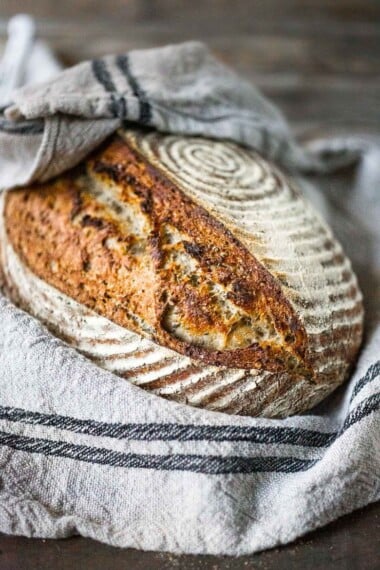

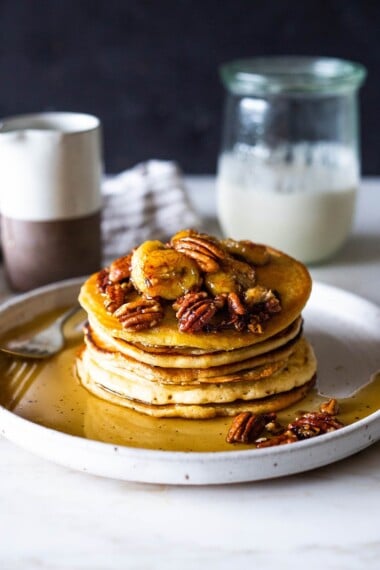
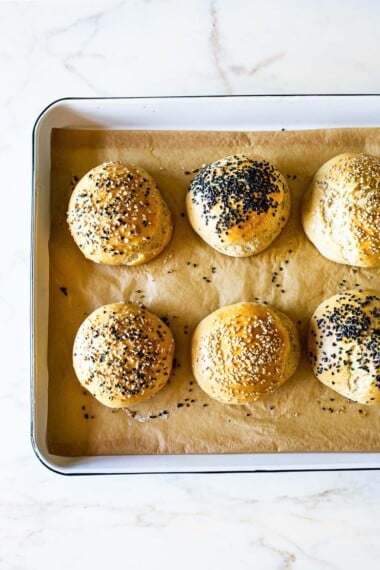







When feeding the starter once a week after refrigerating do you only keep 1/2 cup of the starter and add 1 cup of flour and 1/2 cup of water each time? I’m also assuming you use 1/2 cup of starter when prepping to use in recipes.
Yes, that is correct. It really depends on the recipes- all are different. If making our sourdough bread, you would have enough starter ( 1 cup) for 2 loaves,and ½ cup left to feed.
Hi!
First time making sourdough starter. Everything has gone well till day 4. Day 4 morning my starter had not risen so I waited and waited till 7 pm and fed at that time. It was quite liquidy and sour smelling. It has had such a nice aroma till this point. Is this smell normal?
Today is day 5 and it hasn’t risen but it does have some bubbles. It’s not very runny yet so I am leaving it but again it has the sour smell. Thanks for any help or suggestions.
I’m very excited to try my first loaf of bread!
Hi Audrey the smell sounds normal. I would just keep going- read through the troubleshooting section. If there are bubbles, it’s alive. The sour smell is from it fermenting- all very normal.:)
Thank You so much! I added whole wheat flour yesterday but no rising yet but I will keep going! Thanks again
Just wanted to thank you for the AMAZING sourdough starter and bread directions!
sourdough has always been my Achilles heel. I had previously taken two classes and worked beside an excellent bread baker for many years. What I loved about your instructions were the little insertions of the “why” we do some things. Not always necessary but it really helped me understand the process enough that I can adjust by feel as I go. Recipe writing is an art and you knocked this one out of the park, thank you! 😎
Thanks so much Terri- Glad the starter and bread worked for you!
Hi there!! My sourdough starter seems to be really happy. I fed it at 9:30 last night and at 7:30 this morning it has already quadrupled in size, and is foamy and bubbly. Is it okay to put it in the fridge while I’m at work, to slow down this process and avoid it spilling out all over the place? Thanks!
Sure, either that or get a bigger jar?
I think I’ll have to try the fridge – my jar is already a 1L jar, I don’t have anything bigger! Thank you 🙂
Hello, I’m wondering what the point of using the whole grain flour (I used Rye) is? After going through the whole process of making the starter I want to continue to grow my started so it gets more sour each time. Do I ever add whole grain (Rye flour) to it again after the first initial time or is it just white bread flour from now on?
Hi Russ- whole grain flour has more wild yeast/bacteria in it than white flour- so it kind of gives it a little bump at the beginning. Whenever my starter gets lsow or sluggish, I’ll add a little rye to feeding- it perks it right up.
Hello, I just started, first day, first ever. Same flour as you used, filtered water. 120g. each, but the consistency is very dry and clumpy. It’s in a mason jar and I marked it, just wondering why it is much thicker than your video shows?
Some flours are “thirstier” than others- it should loosen up as it digests. 🙂 And you can always add a little more water- no problem!
I had the same problem as the original commenter with the recommended flour being thick.
If we add water, can that be done at any time or is that recommended during the feeding process?
My starter has gone down in size and has loosened up, just concerned with consistency long term.
Any advice? Thank you 😊
I would add the water when stirring in the flour. If it’s really hard to mix, then add a tiny splash of water.
I had to add some sparkling water to it, made a huge difference. Baked my first bread yesterday, a bit dense, but we like it. I saved my starter, so I keep going.
Do I need the sparkling or still ? An in the tip section the link is for sparkling san pallelgrino so I’m a little confused
Hey Tara- I use exactly what is linked–sparkling. If you can find still San Pellegrino that would work too. Other brands have different mineral contents, and have not worked for me.
Thank you I was a little confused there, as I looked for still but struggled to find it but now I now I can use the sparking water I’ll start tomorrow with it thanks again
Hi! Thank you for this recipe, I have been following this and my starter is sitting happily in the fridge but it is coming up to the first one week feed. I’d like to know after this feed what kind of activity I should be seeing from it? Will is rise or bubble and how long should this take? Sorry if this is covered but I couldn’t find information about this particular question. Many thanks in advance!
Hi Ceci! No problem, after the first week in the fridge, when feeding, it should double in size- this will go very slowly if kept in the fridge for another week- or you can keep it on your counter and it should theoretically double with in 6-8 hours if left out. So if you feed in the morning, you could use it that night. Or, you could use it unfed.
I was finally ready to make my own sourdough starter and came straight to my favorite recipe website for instructions but now I’m a few days in and feeling a bit bamboozled. I definitely regret a bit that I didn’t do more comprehensive research elsewhere on the topic before starting. A few questions-
1) I now know that it’s all about the ratio when it comes to feeding, why did you specifically choose to start from 120g? I now realize that this is an insane amount to work with for typical household needs and it’s just so wasteful. Most other places start with 50g, there are even a lot of people starting with a tablespoon or less these days just so they won’t have to discard as often.
2) I wasn’t really concerned about the waste issue bc I thought “all discards are usable” so it wasn’t a big deal to me… until I learned that most people recommend that you don’t use any discard in baking unless it’s from an already mature starter, especially not if your starter’s less than a few days old. This is because commonly during the first few days the starter rise is actually mostly due to bacteria and not yeast. This is why for a lot of people their starter smells like wet socks for a few days before it mellows out and becomes sour and fruity. Who wants to bake with dough that smells like socks? If you’re not put off by the smell alone, there is technically legitimate concerns regarding food poisoning bc of all the bacteria that’s in the mixture before the yeast finally takes over and the environment gets acidic enough to kill off any bad bacteria. My questions – do you really use discard before it’s from a mature starter, do you really use discard from a starter that’s less than a few days old, do you really use discard that smells unappetizing?
3) this is not such an inconvenience but would’ve been something that is nice to know, but my starter more than doubles within 6 hours after the first/second feed, and this is due to bacterial activity not yeast. Considering how frequently this occurs for people based on my research elsewhere, I’m surprised to not see this kind of growth/its cause described in this recipe.
Hi Bowie, sorry you feel bamboozeled. Responses in order: #1. You can halve the recipe if you prefer, but I’ve done it both ways (side by side) and for some reason the bigger amounts worked more successfully, producing a more active, and most importantly, predictable starter- honestly I have no idea why. #2. I do not use the discard before the starter is mature- but some people like to. #3. I have made/tested starter probably 20+ times, and I have never had this happen to me. I did not know it was bacteria vs. yeast, and I guess I will have to do a bit more research here- thanks for your feedback. 🙂
Can I use freshly milled flour on all days?
Yes, that should be fine!
When using freshly milled flour, should I use hard red wheat or soft white wheat? Thank you so much!
hi Jeni! I really think you could use either?
Good morning
I started your sourdough starter again as mine went bad and I tossed it. I started with organic rye flour and had to let it sit for 2 days because my place is a bit cool. Yesterday I fed it with white bread flour as per your instructions and this morning when I checked it, it had spilled out of the container and all over my cupboard lol what do I do now, should I continue with your instructions till the end? I’m only really on day 2.
Any help would be much appreciated!
Oh dear Christine! Yes, I would salvage ½ a cup, stirred down and just keep going. 🙂
Hi!
My starter is on its 8th day. Unfortunately, there hasn’t been a visible rise and fall nor does it pass the float test. But it does have the tangy smell, it has bubbles, and it is liquidity at the top so it’s still alive!
Should I bake the bread or keep feeding the starter until it passes one of the two tests?
Any insight would be helpful, Thank you!
I would just keep going until you get that rise. It is is not rising in the jar, it will not rise your bread. Read through the trouble shooting section- and start trying those things. Sometimes it is just a matter of time too. It is getting cooler.
Your detailed recipe was so helpful and I especially appreciated your videos and your advice on what to look for when making your starter. I tried other recipes but never had success. Now I have a beautiful healthy starter to make delicious bread and I use my discard for recipes too. Thank you.
So glad you found this helpful!
Hello – yesterday was day 6 and it didn’t double in size and did not float after 8 hours l, now it’s the next morning it’s not double the Size but it is larger and not floating, what do I do? Thank you.
Just keep going Christine- read through he trouble shooting section and start trying those things one at a time. 🙂
For Day 2 (actually 48 hours after starting), I accidentally used whole wheat flour instead of the bread flour. What do I do now? Should I restart the entire process?
No, Mona, just keep going!
Hello, this morning was day 2 for my starter. I fed it according to the directions and it has already quadrupled in size in 7 hours. What do I do??? This is my first time so I’m flying blind over here! 🙂
Just keep going… 😉
Thank you! The starter has now deflated, should I start feeding it today or wait until tomorrow morning?
Hi Rebecca, I would feed it.:)
Hi Sylvia,
One more question- My starter is continually bubbling each day, but, it has not been rising much. Should I just keep going, as long as I see activity and the check the float test on day 7?
Yes, please read through the trouble shooting section, trying each thing on a different day. 🙂 You need to get the rise before trying the float test. Sometimes this can take 2 weeks.
The wheat flour worked! My starter did a nice rise:) Thanks!!
Awesome, so glad!
Hello – I have been making your sourdough recipe for about 9 months and all of a sudden this summer my loaves are flat as a pancake and have no oven spring. I am thinking it could be over proofing. Could I proof overnight in the refrigerator instead of counter? (my kitchen has prob been 74 at night. my starter is doubling but maybe I am mixing after the optimum doubling point and that is affecting the dough? using 14% bread flour. puzzling! Thanks!
It sounds overproofed to me- especially if your starter is healthy & active. You could try it in the fridge or if you are home during the day, try it during the day so you can really gauge it?
Starter was super funky and active first few days, starting day 4 it’s been kinda bla with just some bubbles on top and a runny consistency which is how I determine whether to feed… on day 6 now and it’s been 7 hours since feed but hasn’t grown… keep going a couple more days?
Yes, and read through the trouble shooting section!
Hi Sylvia!
I started my starter and used the scale to measure. Mine looks a lot thicker than yours- it doesn’t pour at all. Very tacky. Is that ok? I am going to let it go overnight and see how it does, but just curious. Btw, I love your website and you do an excellent video.
Thanks!
B.B.I.T. (Bread Baker In Training)
Kim 🙂
Thanks! Yes, it will thin out was it processes the flour!
You were right! I am on day 3 and it has definitely thinned out. I am getting more bubbles too. So far, so good!
Great!
My starter got some fuzz growing on it at day 2! But I hadnt fed it yet because it just started doing something after 48hr…. suggestions? I started with ww flour and water..
When you say fuzz- do you mean mold? If so- toss it and start over.
Hello, thank you for the great instructions, Just I would like to know after the 6th days every time we want to feed we should discard 1/3 ? I want to wait till 10th day to bake a bread, now it’s the 7th day, how much should I discard?
Btw my starter is doing very well thank you so much, also can I bake a bread if my starter was fed 24 hour ago ( outside the fridge) ?
Hey Hasti! To maintain the starter after it is established,, discard all but 1/2 cup and feed that. I would feed it in the morning of baking,and make bread that night.
My starter was raised well beginning after I switched to bread flour It doesn’t rise but liquid on top. I have mixed whole wheat flour into it, and yesterday I tried San Pelligrino but hasn’t raised just little bubble after 24 hours.It has been 2 weeks but not raised, and it’s summer temperature here… should I start over?
Humm… shoot! Sorry to hear that. Sounds like you are doing everything right. How about trying the pineapple juice? Then decide? It is alive if you see bubbles…
Same thing happened to me! I followed the troubleshoot instructions and it didn’t work. I ended up switching from bread flour to organic all purpose flour and it starting rising again after that first feed. I don’t think the bread flour worked for me (I used King Arthur’s organic bread flour).
Oh interesting. I’m glad you were able to get going again!
Hey Sylvia! Thanks for this thorough explanation of how to do a sourdough starter! It’s really helped me!
I’m in need of some help….I’ve had to redo my sourdough starter three times now 😅 I’ve never got past day three lol. 1st time was because I wasn’t putting 1/2 of the starter in a new jar 🤦🏽♀️ 2nd time I forgot to turn on the scale when I was measuring the flour & I forgot to discard half of the mixture & 3rd time I accidentally left the starter in the oven while I preheated it. ALL of this happened on day three 😩 so I am over the fails and not making it past day three lol. Now I’m on day three (once again) and there hasn’t been much rising on any day except day 2 in the morning there was the slightest bit, but there is definitely bubbling. The consistency is like pancake batter. I fed it this morning at 9. It’s almost 1 and no sign of any rising, but there are bubbles. The last three times I’ve made this starter there has been rising each time all on day 2 then a lot on day 3, I’ve done the same thing each time, so I’m not sure what went wrong 😩 I started off day 1 with rye flour & now I’m using king aruthr’s bread flour (I’m in Germany so I have limited American flour access lol). I’m doing half of the recipe so 50g of bread and flour. Well now I’m afraid I might have to start the process over again.
What are your thoughts? Thanks!
I would just keep going if you see bubbles. It is common for it to stall at day 3-4. Just push through and wait til it is super runny to feed.
I have a question. Last Monday was day one for me. It was doing great!! Day 4 it ran over. Since then it’s not doing anything. I do get little bubbles. It does get little runny. I have tried pineapple juice, tried going back to the whole wheat like you recommended. It’s been almost 48 hours since the last feed only bubbles. What do you recommend now?
My family has enjoyed the sourdough pancakes and buns with the leftover. So thanks so much for sharing.
I would try the San Pelligrino (instead of water)- and YES, specifically that brand- and maybe a little rye flour mixed in with the bread flour. This always jumps starts my starter.
Thanks. I picked the stuff tonight. So I will try that.
My starter is looking amazing on Day 6! Thank you for your recipe and recommendations. I tried a starter last week with no luck and then found your site. Now I am extremely nervous to make the bread. I’ll come back and let you all know how it goes.
YaY Brandi! Congrats! Yes, please give an update!
Day 3 started Thursday at 9 am. and it has almost been 36 hrs now and it hasn’t doubled. It is very runny. Should I wait a full 48 hrs before feeding it for day 4?
If it is very runny, it is time to feed it. 🙂